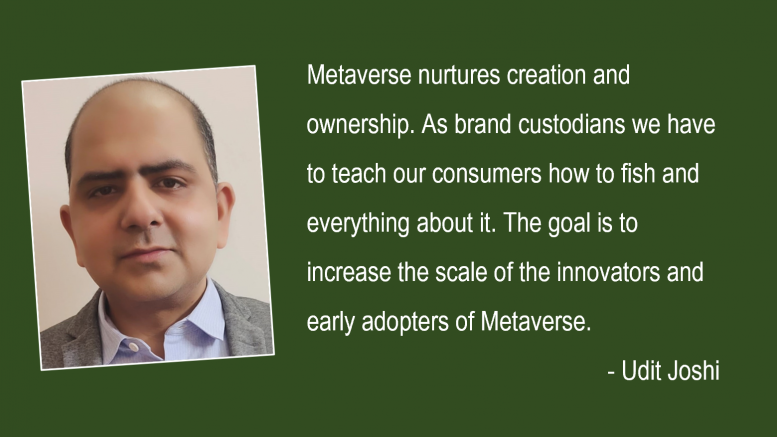The cost of explaining a concept, an idea, a technology or a product for effective consumer adoption is its ‘cost of communication’. To be honest, in the case of Metaverse it is a mere fraction of its actual value of production. The diffusion theory of marketing was in sync with the innovators. But it got scattered up the curve from the early adopters, the early majority and onwards. Myths, misnomers and monikers came into existence as there was a rush to write on this subject. It became a part of non-work customary conversations, but to a peripheral point. There is hype about Metaverse everywhere, yet that word cloud is yet to have the word ‘disruption’.
We have seen many hype cycles go by in the tech industry, which have resulted in becoming bubbles. Indiana University’s media professor Edward Castronova, told CNBC that virtual real estate is like a pyramid scheme. He said, “Metaverse is the El Dorado for internet startups”. The latest tool in practice by public relations pros – AnswerThePublic, depicts the direct line to the consumers’ thoughts. In the case of the Metaverse, the audience seems to be the sceptics. The questions searched on the subject are vague; reflecting their insecurity, rather pessimism.
Where is the Metaverse audience?
So far, the world’s less than 1% brands have invested their big bullion in the Metaverse. To give the customers an immersive experience of the product, brands have created virtual environments. Nike, Ferrari, Samsung, Hyundai, Coca-cola, Sentosa, Adidas, Gucci are the pioneering B2C brands in the Metaverse. In the ‘virtual real estate’, Decentraland, the most significant player is shaping has only thirty eight ‘Daily Active’ Users. Yes, 38 users in an USD 1.3 Billion ecosystem. Another platform Sandbox has 522; if that normalises the scale. (These numbers are basis parameters of transactions and capital interactions. They have de-grown with time). The Metaverse is an enormous space and it is hard to find potential customers.
The Sense behind the Science
At the core of this hype is the vision of Decentralised lives. Decentralisation is the peak of human evolution over several hundred years. Internet Technology has reduced the time spent in each stage of advancement. The Web 2.0 adoption was faster than Web 1.0 and the non-internet era held us for a long time with the television and phone. The newspapers and books as media of information were the longest. Drawing a parallel with societal evolution, the monarchs ruled the early civilisations. With time, we felt safe with socialism’s equal distribution of wealth. In more recent centuries came the democracies where we exercised choice and capitalism. As we become global citizens now, the rules of the economy have to naturally change. From a state of governance by others, we now have the power to govern ourselves. This brings in ownership and control of wealth creation which is the principle of Web 3.0.
Clearing the muddled definitions
I have had conversations where people have used cryptocurrency, NFTs and blockchain interchangeably. It calls for the authorities and businesses to increase the cost of communication. A clear understanding of the ecosystem needs to become accessible to all. The lack of knowledge has led to enterprises becoming apprehensive of Blockchain adoption. Businesses have a mental-resistance assuming that, ‘the market is ambiguous and volatile’, these days. This misinformation and lack of awareness is costing dearly to the economy at large. Blockchain, NFTs, Metaverse, DAOs, Daaps, Cryptocurrencies all are part of the same ecosystem. They are, yet, mutually exclusive in their functions.
Communication flow of a new technology
Several technologies working together enable the convergence of our physical and digital lives. I remember pleading with my parents to get the computer when home internet got affordable in the summer of 99. We studied thick manuals and guide books before we hit its utility and application. Today’s India has digital natives who are much closer to decentralisation in practice. They are a part of the creator economy in one way or the other. Institutions, brands and consumers have to impart the knowledge of metaverse and collaborate. The Web3 infra, blockchain and tools such as AI, VR, AR, 5G, edge computing, will create disruptions.
Communicating applications and possibilities
For a technology worth billions, a significant investment on its communication is elementary. Atleast, a 100 X higher than the present numbers for a desirable adoption. The current push by the brands has made Metaverse aspirational and less utilitarian. Wealth creation is one part of it which attracts the chunk. But there’s a whole new world more to Metaverse. The capabilities go far and beyond and gaming, education, L&D, Human Resources, Aviation, Construction, Infra are but just the tip of the iceberg.
Metaverse nurtures creation and ownership. As brand custodians we have to teach our consumers how to fish and everything about it. The goal is to increase the scale of the innovators and early adopters of Metaverse. As we enable building a knowledge society, the Metaverse is bound to reach its pinnacle on its own.
The views and opinions published here belong to the author and do not necessarily reflect the views and opinions of the publisher.



Quite insightful @ Udit ji. Must read